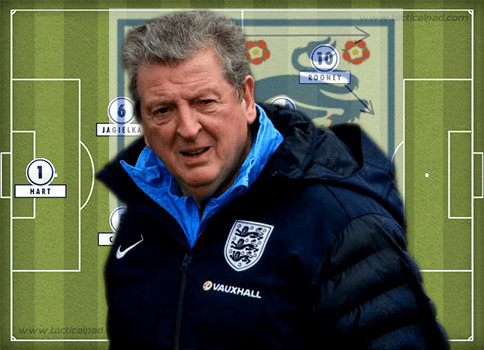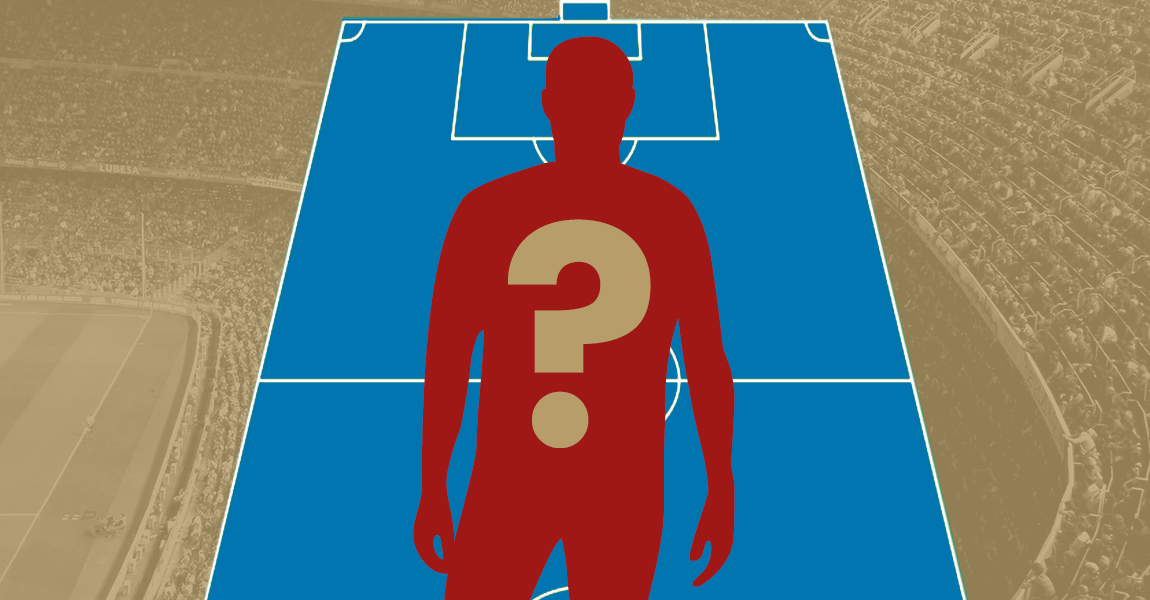In the upcoming friendlies and leading up to the World Cup, Hodgson will likely experiment with various combinations and several roles will be addressed. No doubt that ‘formations’ shouldn’t be taken too literally and roles within each system should be given more importance, but the decision of how to accommodate both Rooney and Sturridge will be an issue. In England’s match against Denmark, a rotation between the two occurred in the first half, where one would come inside from the left and Sterling would maintain the width from the right and rarely played inside. A trend likely to be used.
BASIC FORMATION

While there are a few different combinations that Roy Hodgson could employ this summer in Brazil, it is most likely that he will stick to the 4-3-3 that he has tried before. That, and some of the other possibilities have been analysed below.
ANALYSIS
4-3-3 | The Inverted Winger
In terms of build-up play in the first third, England use the method of splitting both centre backs and using a single holding midfielder to drop between, creating as much space as possible, enabling playing out under pressure from 1 or 2 strikers as well as a very high press. Even if passing lanes are cut off Hart is often used, and is able to find full backs who are high as well as Gerrard with a lofted pass.
If the opposition decides to play in a mid-low block, patience is evident. Continuous switching of play occurs, with often limited penetration. From this, another midfielder drops deep, in an attempt to lure the opposition into a press, opening up space between the lines for the third and most advanced central player.

The space between the lines created as a result of this movement can also be exploited by England’s use of the ‘Inverted Winger’ (Sturridge here), who will frequently look to play in the space between the vertical lines as well as horizontally. Within the early stages against Denmark, Sturridge and Rooney rotated in this role, as Hodgson experimented how to utilize both strikers whilst keeping within a variation of 4-3-3. The use of the inverted winger, causes decisions within the opposition of who should mark the player and how the defensive structure should change to limit this player’s influence. Pressure from a centre-back means a basic 2v2 combination with the striker, and tight marking from the opposition right back encourages overlaps from Baines/Shaw to exploit the space.
Below the example shows a central midfielder marking the movement from the inverted winger as he attempts to combine with the full back. This opens up the space between the lines for an advancing central midfielder.

Although this highlights how the system can be used to penetrate Zone 14, Sturridge’s movement closes the space around the full-back, and a penetrating pass into Henderson is required straight away. The best chance of success comes through the right, often through tucking all players over to the left hand side, and after quick combinations switching play to Johnson and Sterling who will be able to exploit the space.
Without the ball, England organize into a mid-low block and look to press when in an organized shape. The striker will cut off any chance of a switch between the centre backs and encourage the pass forward, where England will try and win the ball in midfield.The issue with Rooney’s role of preventing the switch and encouraging forward passes, is that if the space between the lines are too stretched, playing between them becomes easy. Also the player ‘s movement to receive the ball between the lines needs to dealt with by the closest defender but also support from a midfielder and that the space left is covered to prevent any chance of a third man run into the vacant space.
Soon after losing the ball, the initial response is to retreat to clear 4-1-4-1 structure before attempting to press in a structure similar to which has been previously highlighted. Using the one winger playing inside (Rooney here), means obvious space to exploit if the switch of play occurs straight after the opposition gains possession.
The 4-2-3-1 | A Slight Variation
Another option for Hodgson is to play Rooney in a ‘number 10’ role behind Sturridge, with Welbeck/Oxlade-Chamberlain and Sterling providing constant width, making penetration through the middle easier. With two advancing full backs, this will likely mean two from Henderson/Gerrard/Lampard/Wilshere/Milner making up the double pivot. The obvious issue is that can Lallana and Barkley both be omitted from the starting eleven? As spoken about above, the use of the inverted winger on one side could mean one of the two could play coming in from a wide area but defensive responsibilities need to be fulfilled.
4-4-2 not an option?
In another recent match against Germany, Rooney and Sturridge started in a partnership up front, and despite earlier positives from high pressing, the issues of the system became evident. Germany playing backwards here encourages Rooney and Sturridge to press but as Rooney cuts off the switch through an exaggerated body shape, the holding midfielder drops deep and a simple pass is needed to play out of this first line of pressure.

In terms of the space between the defence and midfield lines, if the striker drops in, one centre back can mark tight whilst the other covers the space. When the lines are close there is usually sufficient pressure to disrupt the striker, but if the striker is able to pass the ball into players who have advanced beyond him, combinations can occur with space to exploit. Here the winger moving inside drags Walker into the space and Gerrard & Townsend who have lost their markers allow unmarked attacking runs.

On negative transitions there is also issues when playing two central midfielders against a three. A midfielder is able to exploit the space left if both England central midfielders overcommit to attacks. The movement of the striker on the left of the photo below moves Smalling out of position as he is instructed to mark tight and further space is created.

As the game goes on, lines between the units can be further stretched and can be played between easier.
An option for Liverpool’s diamond?
Five players of the above eleven have been used in this system at Liverpool. A perhaps bold decision to implement this within a short period, but using fullbacks who possess ability to perform in attacking areas can be complimented by all-round players in Henderson and Milner. This will accommodate both Rooney and Sturridge as well as promoting the creative ability apparent in central areas with Sterling, Barkley, Oxlade-Chamberlain or Lallana in the most advanced role.

KEY PLAYER
Wayne Rooney | Perhaps obvious, but when you consider that in the next world cup, Rooney will be 32, this is an obvious opportunity for his career to peak, if it hasn’t already happened. Recent claims from former teammate Scholes suggests that he may have already reached his highest levels and there are questions about whether the England staff would even consider not playing him. The player’s talent is unquestionable, 19 goals in a season deemed as a failure at United is a reasonable achievement and there’s no excuse not to shine in Brazil. The level of talent around him means competition for places will be high, demanding high levels of performance.
TALENT RADAR KEY YOUNG PLAYERS
Raheem Sterling | The improvement of the exciting 19 year old this season is nothing short of remarkable, and with Walcott injured, the Liverpool youngster is extremely likely to start in Brazil. The attacking attributes he possesses make exciting viewing as well as bringing success on the pitch, scoring 9 goals in the process. His adaptability in wide areas as well as playing behind the striker means that in future years there’s an exciting chance he will be a guaranteed starter, while now he seems to be the best of the younger group, with phenomenal ability for someone his age in that position.
Ross Barkley | Like Sterling, Barkley features in the Premier League #TalentRadar team of the season. His individual attacking qualities are evident, with strong running ability, frequent 1v1 domination as well as an ever increasing decision making ability. Competition in his preferred attacking midfield role will be fierce, but hopefully gets enough game time to express his talent.

Courtois (Atletico) – Marquinhos (PSG) – Laporte (Bilbao) – Carvajal – Shaw (Southampton) – Koke (Atletico) – Pogba (Juventus) – Barkley (Everton) – Sterling (Liverpool) – Berardi (Sassuolo) – Lukaku (Everton)
Both Sterling & Barkley featured in Outside of the Boots’ list of 100 Best Young Players to Watch in 2014, coming in at #6 while Ross Barkley was at #3. Both of them even made it into the #TalentRadar Readers’ Team of the Season at the 2013-14 #TalentRadar Young Player Awards.
CONCLUSION
There’s no doubt that with this selection, there will be hundreds of individual debates, Lallana or Barkley, Milner or Henderson, should Lampard play? Considerations will be taken on the positives and negatives the combinations will bring and how to exploit the opposition’s weaknesses. England fans will be hoping the younger players who have performed well at club level are given the chance, and that experimenting in the upcoming friendlies can help decide the ‘best eleven’ for each opponent.
This piece was written by Jack Radusin. Follow him on Twitter @JRadusin
Read all our World Cup Tactical Previews here, and all other WC2014 related content here.

























































